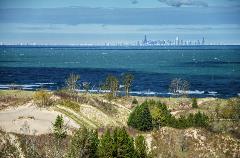 Minnesota > Aquatic invasive species are animals or plants that are introduced into ecosystems beyond their natural range. In the Great Lakes, this often happens through the release of ballast water used to balance large ships. As part of a broader effort to combat invasive species, the League’s Minnesota Division secured several large grants to test a system for eliminating invasive species from ballast water.
Minnesota > Aquatic invasive species are animals or plants that are introduced into ecosystems beyond their natural range. In the Great Lakes, this often happens through the release of ballast water used to balance large ships. As part of a broader effort to combat invasive species, the League’s Minnesota Division secured several large grants to test a system for eliminating invasive species from ballast water.
More than 180 non-native species have invaded the Great Lakes, damaging native fish and wildlife and local economies. One infamous invader is the zebra mussel. Power companies along the Great Lakes now spend millions of dollars each year to monitor and control zebra mussels that clog cooling water intake pipes. (Ironically, the University of Wisconsin Sea Grant Institute reports that invasive species were less of a problem before the 1970s because American harbors were so polluted that nothing could survive in the water!)
Sport and commercial fishing as well as tourism and recreation can also suffer when invasive species decimate native aquatic ecosystems. A 2012 study by researchers at the University of Notre Dame found that the median (middle) economic cost of aquatic invasive species introduced into the Great Lakes was $138 million per year. What’s more, when looking in particular at the impact on sport fishing, researchers said there was a chance that the economic impact could be as high as $800 million per year.
 To prevent new invasive species from entering the Great Lakes through ballast water, the Minnesota Division has been working for years with Phyllis Green, superintendent of Isle Royale National Park, who is leading National Park Service efforts on aquatic invasives. Green implemented ballast water treatment on a Park Service motorized vessel and scaled up those treatment options for the largest ships on the Great Lakes. (The League recognized her commitment to conserving the Great Lakes with an Honor Roll Award in 2010.) The key is to kill invasives in the ballast water but not harm native species when the treated water is released. The Minnesota Division has been working to help fund a series of tests to prove the kill-rate efficacy of a mobile version of this ballast water treatment system, which could be deployed across the Great Lakes to treat ships suspected of carrying invasive species.
To prevent new invasive species from entering the Great Lakes through ballast water, the Minnesota Division has been working for years with Phyllis Green, superintendent of Isle Royale National Park, who is leading National Park Service efforts on aquatic invasives. Green implemented ballast water treatment on a Park Service motorized vessel and scaled up those treatment options for the largest ships on the Great Lakes. (The League recognized her commitment to conserving the Great Lakes with an Honor Roll Award in 2010.) The key is to kill invasives in the ballast water but not harm native species when the treated water is released. The Minnesota Division has been working to help fund a series of tests to prove the kill-rate efficacy of a mobile version of this ballast water treatment system, which could be deployed across the Great Lakes to treat ships suspected of carrying invasive species.
The Minnesota Department of Natural Resources and the National Park Service each committed $50,000 to this testing effort. The board of commissioners for St. Louis County (located in northeast Minnesota) recently approved a grant of $50,000 to support the project as well. St. Louis County is home to numerous publicly accessible lakes. “While also approving dollars for boat washing stations and educational programs, the St. Louis County board recognized that an ounce of prevention can really, if successful, be worth more than a pound of cure,” says Dave Zentner, a former national League president who is a member of the League’s Great Lakes Committee.
“The Minnesota Division of the Ikes has long recognized the need to spend more time working to prevent new invaders,” Zentner says. “Led by Jill Crafton, who chairs the League’s Great Lakes Committee, League members supported securing the necessary funding to test this system in salt, brackish, and fresh water; peer review the studies; and ultimately move into regulatory agency approval at the federal level.”
Zentner says McCabe Chapter members and St. Louis County commissioner Frank Jewell were particularly critical to the St. Louis County board approving the grant. Efforts are now focused on securing a commercial ship on which to test the mobile treatment system. The $150,000 in com- bined grants will cover the cost of one test.
“Much more needs to be done, but persistence does, at times, return rewards,” Zentner says. “The Minnesota Ikes are very appreciative of this support!”